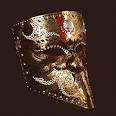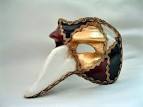The History of the Venetian Carnival Mask
Mardi Gras is famous for several novelties-The King Cake, the infamous colorful beads, the grand parade, and the mystery characters behind the colorful carnival masks. Whether you're a woman wanting to seduce a young man or a gentleman wanting to swoon a lady into a passionate kiss, the mask allows all taboos to be brought out of the shadows and into the world of seduction.
The Carnival mask has a long history steeped in rich Venetian culture. During the Renaissance in the seventeenth century the Venice carnival encouraged licence and pleasure , but was also used as a distraction during the depression of the times until the King of Austria outlawed the festival in 1797. The masks were then forbidden. The nineteenth century brought a resurgence of the carnival and the tradition of the mask.
The masks were made of various materials. From leather to porcelain to glass, the original mask was made to keep the wearers identity hidden while he or she enjoyed the festivites. Today the masks are celebrated for the same purpose. Whether in Venice or New Orleans the carnival is a time to find one's alter ego and let all inhibitions fall into the abyss.
The masks vary in design and style. There are many genres, each demonstrating ecclectic characterists and embelishments.
The Bauta mask is designed to comfortably cover the entire face. An over prominent nose, projecting chin line, and no mouth characterize this mask. This was a mask to disguise members of the Venetian government.

The Columbina mask is a half-mask, only covering the wearer's eyes, nose, and upper cheeks. This mask was created for a beautiful actress who didn't want her face entirely covered. While the mask began as a woman's party favor, it is widely worn by both men and women today.

The Medico della peste mask is familiar to most with it's elongated beak. This mask has more practical roots. It began as a mask worn to prevent the spread of disease. While worn by physicians to treat patients suffering from the plague, it's worn today as a grotesque respresentation of the Venetian style mask.

The Moretta muta mask was a small strapless black velvet oval mask with no lips or mouth holes worn by patrician women. Women would bite on a button beneath the mask to keep them from speaking therefore furthermore concealing their identity.

The Volto is the iconic modern Venetian mask. It's commonly worn with a tricorn or cloak. This mask covers the entire face. It depicts the simple facial features like the nose and lips.

The Pantalone is a classic from the Italian stage. This mask is a representation of the father figure. It signifies intelligence on the stage.

Over the years the mask has come to symbolize many characters, from the physician to the politician the masks purpose has been to hide the identity of it's wearer by means of protection from disease or to seduce the throng of festival participants. The mascherari, or mask maker, has given the Mardi Gras culture it's distinctive mysterious spin. It's Les Carnaval! Laissez les bons temps rouler!
Pauline Allen's Blog
- Pauline Allen's profile
- 4 followers



